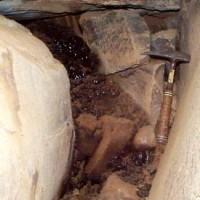Murdoch University
Source - http://phys.org/news/2012-11-year-old-dna-poo-window.html#jCp

Murdoch University DNA scientists have used 30,000-year-old faecal matter known as middens to ascertain which plants and animals existed at that time in the hot, arid Pilbara region of North Western Australia.
To date, this is the oldest environmental sample from which DNA has been obtained in Australia. It had previously been considered unrealistic to extract DNA from hot, arid zone samples due to the extreme heat.
PhD candidate Dáithí Murray from Murdoch's Ancient DNA Lab said that comparing the genetic signatures obtained from old material such as middens to present day plant and animal surveys would allow for an exploration of how these regions had adapted and shifted in response to both natural and human impacts.
Mr Murray successfully extracted DNA samples from midden material – which consists of animal faeces and urine, plant and animal tissue as well as bone, hair and eggshells which had become cemented together over hundreds of years – in four locations. Three were sampled from hot, arid regions in Western Australia and one from South Africa's Western Cape province, all of which were between 700 and 30,000 years old.
"Cool and frozen environments are considered most suitable to long-term DNA preservation," explained Mr Murray, whose paper on genetic profiles from middens has been published in the journal Quaternary Science Reviews.
"But new ancient DNA technologies and techniques have allowed us to take a closer look at these warm but dry environments, which have a delicate ecological balance, and are therefore of considerable environmental and biological interest.
"With regard to DNA preservation, there is something special about middens in arid environments – we were not expecting some of these samples to work but they did! I suspect that the exclusion of water and the chemical make-up of the midden generates some favourable conditions for DNA."
A range of plant and animals, some of which are now locally extinct, were detected, such as the common brushtail possum found in one midden in the Cavenagh Range in WA. Mr Murray was also able to identify flora and fauna that had previously gone undetected in different types of studies, such as a range of previously indistinguishable arid zone grasses.
"Most of the information we have about ancient arid environments has come from a variety of studies into middens including carbon dating, pollen identification and macrofossil techniques," said Mr Murray. "The DNA techniques we use can compliment these studies.
"Multidisciplinary investigations of midden material can ultimately inform conservation and rehabilitation policies today. Put simply, we cannot monitor environmental change if we have no baseline to compare it against – these middens provide the time capsule we need to make those comparisons in the arid zone.
"In regions such as the Pilbara, DNA work of this kind could be a key addition to the assemblage of palaeoenvironmental data, as the midden used is dated to a time for which almost no such regional data exists."
Mr Murray said his research would hopefully lead to a greater focus on genetic profiling of hot, arid and semi-arid environments across the globe, including in Africa, Australia and the Middle East.